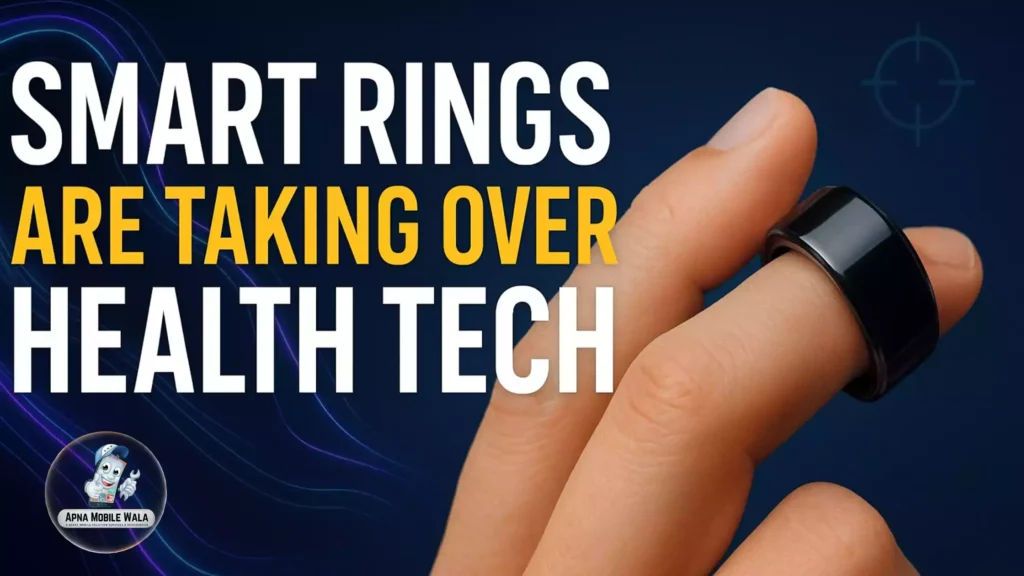The Rise of Smart Rings and Their Impact on Health Tech
Wearable technology in healthcare has rapidly evolved over the last decade. From fitness trackers to smartwatches, people are embracing devices that help them monitor, manage, and improve their health. Now, a new player has entered the scene — smart rings. Small, stylish, and packed with sensors, these rings are transforming how we think about health monitoring.
In this article, we’ll explore the impact of wearable technology in healthcare, specifically focusing on smart rings, their benefits, challenges, and the future of wearable technology in healthcare.
What Are Smart Rings?
A smart ring is a compact wearable device designed in the shape of a ring but with built-in sensors that track health metrics. Unlike bulky fitness trackers or watches, smart rings are discreet, lightweight, and comfortable to wear.
Some of the most common features include:
- Heart rate monitoring
- Blood oxygen levels (SpO2)
- Sleep tracking
- Activity tracking (steps, calories burned, movement)
- Stress monitoring (via heart rate variability)
- Contactless payments (in some models)
Brands like Oura Ring, Ultrahuman Ring AIR, and Circular Ring are leading the market, showing that this trend is more than just hype.
Why Smart Rings Are Gaining Popularity in Healthcare
The demand for smart rings is driven by a mix of convenience, accuracy, and style. Let’s break down why they’re making waves:
1. Discreet Design and Comfort
Unlike watches, which can feel bulky, rings are subtle and comfortable. People can wear them 24/7, including while sleeping, making continuous health monitoring easier.
2. Advanced Health Tracking
Modern smart rings provide near-clinical accuracy for health metrics. For example, sleep tracking with Oura Ring is often cited in research for its reliability.
3. Integration with Healthcare Systems
Many smart rings allow users to share data with healthcare providers, making it easier for doctors to track patient health trends remotely.
4. Lifestyle and Wellness Appeal
Beyond healthcare, these rings appeal to those interested in wellness, fitness, and even stress management.
The Impact of Wearable Technology in Healthcare
The impact of wearable technology in healthcare goes beyond personal fitness. Here are some ways smart rings and other wearables are changing the industry:
1. Remote Patient Monitoring
Doctors can remotely monitor patients with chronic conditions like diabetes or heart disease using real-time data from smart rings. This reduces hospital visits and improves preventive care.
2. Early Detection of Health Issues
Smart rings can track anomalies in heart rate or oxygen levels, potentially alerting users about early signs of illness. For example, irregular patterns in resting heart rate can indicate infections or cardiac issues.
3. Improving Sleep Health
Since poor sleep is linked to numerous health problems, smart rings’ advanced sleep tracking helps users adopt better sleep hygiene practices.
4. Encouraging Preventive Healthcare
Wearables shift healthcare from reactive (treating illness) to preventive (avoiding illness), empowering users to make lifestyle changes early.
5. Data-Driven Healthcare Decisions
With continuous data, healthcare providers can make more informed decisions, improving treatment accuracy.
Real-Life Examples of Smart Rings in Action
- Athlete Performance Tracking: NBA players have reportedly used Oura Rings during training camps to monitor recovery, sleep, and readiness.
- COVID-19 Early Detection: During the pandemic, studies showed that Oura Ring could detect early signs of COVID-19 by monitoring temperature and heart rate fluctuations.
- Corporate Wellness Programs: Companies are adopting smart rings for employee wellness, reducing stress and promoting productivity.
Challenges and Limitations of Smart Rings
While promising, smart rings come with challenges:
- Cost Barrier: Premium models can cost $250–$400, limiting access.
- Accuracy Concerns: While advanced, they may not always match medical-grade equipment.
- Data Privacy Risks: With sensitive health data involved, security is a concern.
- Battery Life: Most smart rings last 4–7 days before needing a recharge.
- Cultural Acceptance: In some regions, people still see wearables as unnecessary luxury items.
Future of Wearable Technology in Healthcare
The future of wearable technology in healthcare is bright, with smart rings leading innovation. Here’s what experts predict:
1. Medical-Grade Smart Rings
Future rings may receive FDA approval as diagnostic tools, making them trusted medical devices.
2. Integration with AI and Big Data
AI can analyze wearable data to predict diseases, while big data can help identify health trends at population levels.
3. Personalized Healthcare
Wearables will allow highly personalized health recommendations, tailored to each user’s data and lifestyle.
4. Insurance Incentives
Health insurance providers may offer discounts to people who use smart rings, encouraging preventive health monitoring.
5. Global Adoption
As costs decrease, more people worldwide will adopt these devices, making healthcare accessible even in remote areas.
Health Precautions and Legal Considerations
While smart rings are useful, it’s important to remember:
- Not a replacement for doctors: They can guide you but should not be the sole source for medical decisions.
- Accuracy may vary: Readings can fluctuate due to fit, skin tone, or movement.
- Data sharing: Be cautious when sharing health data with apps or third parties.
Disclaimer: Information in this article is for educational purposes only and should not be considered medical advice. Always consult a healthcare professional for medical concerns.
FAQs on Smart Rings and Health Tech
1. Are smart rings more accurate than smartwatches?
Smart rings often provide more accurate sleep tracking due to their position on the finger, closer to blood vessels, but accuracy can vary by brand.
2. Can smart rings detect diseases?
While not diagnostic tools, they can detect irregularities (like changes in heart rate or oxygen levels) that may indicate health issues.
3. How long does a smart ring last on a single charge?
Most smart rings last between 4–7 days, depending on usage and features.
4. Do doctors trust data from smart rings?
Many doctors find wearable data useful for trends, but they still rely on clinical tests for diagnosis.
5. What is the future of smart rings in healthcare?
They are expected to become smaller, more accurate, integrated with AI, and potentially recognized as medical-grade devices.
Conclusion: Smart Rings Are Shaping the Future of Healthcare
Smart rings represent the next frontier in wearable health technology. By combining comfort, style, and advanced health tracking, they’re making healthcare more personal, preventive, and data-driven.
As technology advances, the impact of wearable technology in healthcare will only grow, with smart rings at the center of innovation. Whether you’re a health enthusiast, a patient, or a healthcare provider, these tiny devices hold the potential to revolutionize how we care for our health.
👉 If you’re curious about the future of wearable technology in healthcare, now is the perfect time to explore smart rings. They might just be the small device that makes a big difference in your life.
Read more
- Top 5 Casio Watches Under ₹2,000 for Men
- Gemini Prompts for Image Generation Trending (Best AI Prompts for Boys 2025)
- The Perplexity Comet Browser: Your Ultimate Guide to Downloading and Using the AI-Powered Search Revolution
- Amazon Door Ring Bell: The Ultimate Guide to Wired & Wireless Smart Doorbells in the U.S.
- Harman Kardon Aura Studio 4 Review: Is It Still Worth Buying in 2025?



